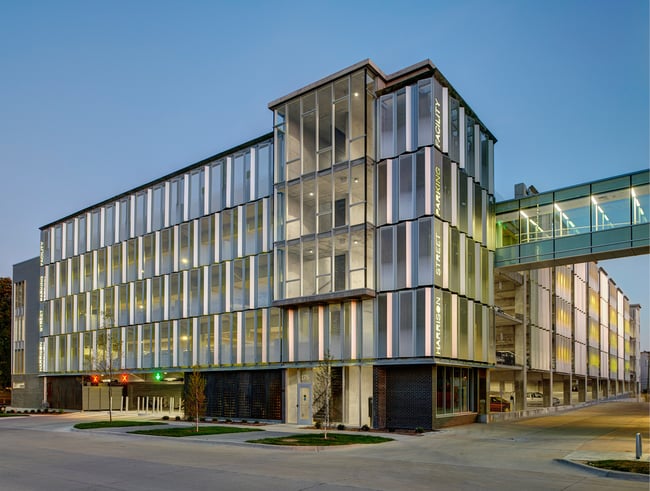Pros and Cons of Post-Tensioned Concrete: An Architect’s Perspective

The early stages of the architectural process are a time to make large-scale decisions related to the building’s form and structure. During this time, your design team may present different structural system options, discuss benefits and drawbacks, and make recommendations.
One recommendation may be post-tensioned concrete. This method introduces tension to the concrete after curing to strengthen the structure, reduce the likelihood of cracks, and allow for thinner slabs.
While this structural system offers many advantages, it can limit flexibility and complicate future modifications. We recommend considering your long-term goals and the potential for renovations and retrofits.
To help you with your decision, this article will define post-tensioned concrete and outline its pros and cons.
What is Post-Tensioned Concrete?
Post-tensioning is a method of reinforcing concrete by introducing tension after the concrete has achieved a specified strength.
Tension is introduced through high-strength steel stands or bars, typically called tendons. During construction, these tendons are placed in forms before the concrete is poured. The tendons are then tensioned with hydraulic jacks after the concrete cures.
While concrete works best under compression, steel works best under tension. Post-tensioning maximizes the use of each material for efficiency. It can be thought of as a “sweet spot” that provides the strength of concrete and steel without overusing either one.
Often, post-tensioned concrete works well for parking structures and high-rise commercial or residential developments. We have also seen this method used for tennis courts.
In this situation, the tennis courts sat over an unstable site once occupied by a city dump. Post-tensioned concrete’s strength prevented cracking or vibrating that would likely occur with a more traditional concrete system.
Pros of Post-Tensioned Concrete
The most significant benefit of post-tensioned concrete is its strength. The combined performance of concrete and steel allows for thinner slabs and longer spans.
Achieving the same strength with another structural system would require more columns and deeper beams. For this reason, post-tensioned concrete best aligns with structures where longer spans are desired, like parking structures.

Post-tensioning's ability to provide longer spans works well for parking garages.
Post-tensioning also allows designers to decrease a building’s floor-to-floor height—the vertical distance between the finished floors of two consecutive levels. Other systems require deeper beams and thicker slabs, increasing the distance between floors.
As such, post-tensioning can reduce a building’s overall height and lower costs for components like façade treatments. In short, post-tensioned concrete improves material efficiency, minimizes waste, and allows for more open interiors. It can help solve multiple challenges—from cost concerns to aesthetics and performance.
Cons of Post-Tensioned Concrete
Although post-tensioned concrete offers many benefits, it can complicate future modifications to the building. Vertical penetrations must be planned during the design process due to the tendons, and after construction, you can only cut through these pre-planned areas. If you cut through the tendons, the structure loses its strength.
With these limitations, post-tensioned concrete works best for buildings with stacked layouts, like residential construction and parking garages. Buildings requiring more flexibility, like healthcare facilities, may run into problems in the future. For this reason, some organizations—like the General Services Administration (GSA)—have rules against using post-tensioned concrete.
Although post-tensioned concrete can be limiting, other structural systems present a degree of inflexibility. A more traditional concrete system requires more columns, which can also complicate modifications. You and your design team should discuss the potential for future changes to determine the right approach.
At the same time, post-tensioned concrete can add complexity to construction. It requires precision and specialized knowledge, potentially limiting your options to a smaller set of contractors.
Is Post-Tensioned Concrete Right for Your Project?
Post-tensioned concrete is a popular structural system for large-scale developments. Depending on your project type and goals, your architect may recommend it in the early stages of the design process.
Combining concrete and steel’s strength, post-tensioning can reduce cracking and help achieve longer spans and lower floor-to-floor heights. It can also lower initial costs by improving efficiency and reducing building height.
Despite the benefits, post-tensioned concrete is not ideal for every project. If you desire more flexibility, a more traditional concrete or steel structural system may be a better fit.
For buildings with stacked layouts—like parking structures and residential developments—post-tensioned concrete may be the right solution. Learn more about these building types by reading about the rules of thumb for parking structure design and considerations for high-rise construction.